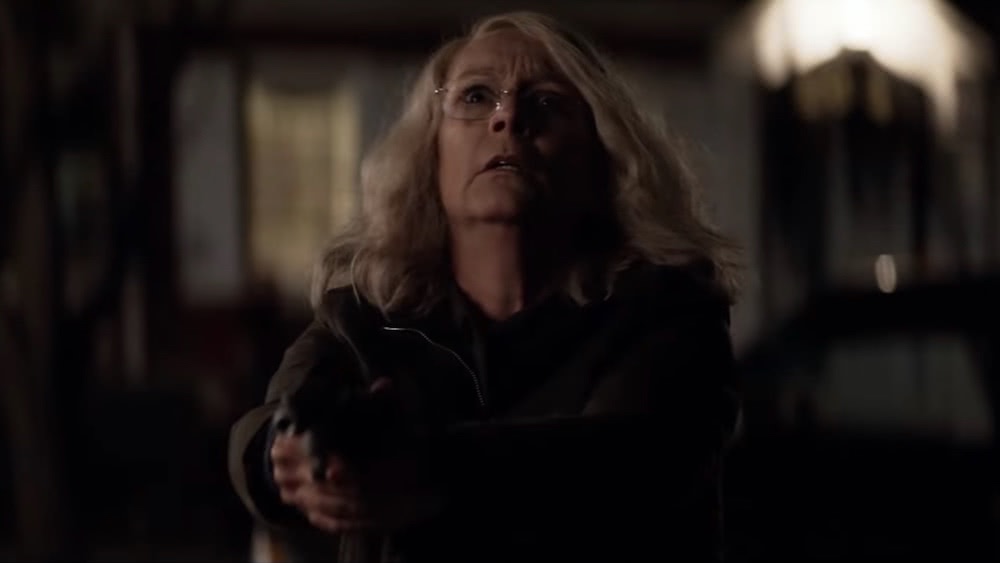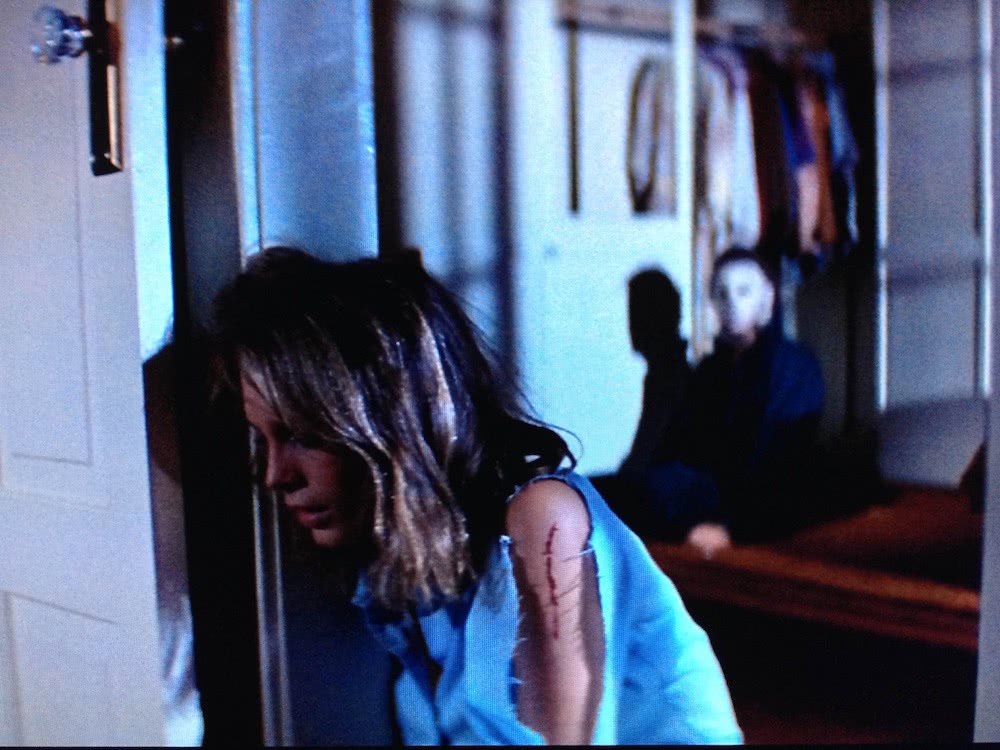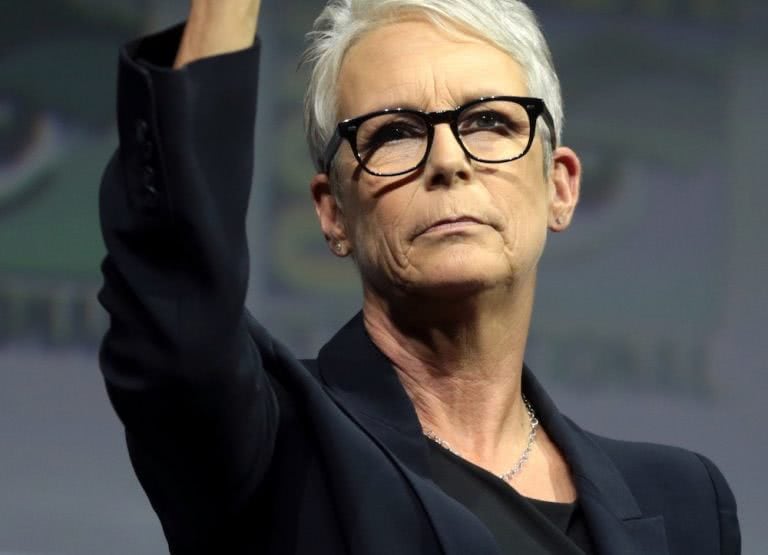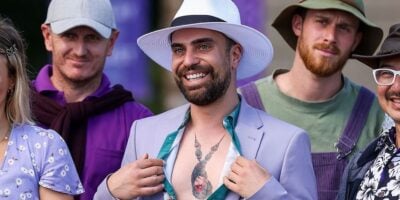The sun is yet to rise and 59-year-old Jamie Lee Curtis is lying in the mud in Charleston, South Carolina. Her rib has fractured after having fallen from a roof. “I was lying in a muddy, kind of murky, swampy area – I was in a lot of pain, but I was trying to grin and bear it,” she says, painting the memory of being onset for the new Halloween film. “And there was just this moment, I remember it, going, ‘What am I doing?’” She throws up her hands and laughs.
As the mud seeped into her character’s clothing – the staunch grandmother Laurie Strode – a thought came to Curtis: “I miss my husband, and my son, and my daughter, and my family, and my dog, and my life.”
Throughout her 40-year-long career, Curtis has been a stickler for doing her own stunts. In James Cameron’s ’90s action thriller True Lies she refused to let her double do the helicopter scene, and wilfully suspended herself 60 metres above the sea.
Although acting in the new Halloween, a sequel to 1978’s shocking original was physically painful and emotionally taxing, Curtis made it clear on The Project that “anyone trying to raise a couple of kids or hold a couple of jobs works way harder than I’ve ever worked a day in my life.”
Getting the role of a sweet, pot-smoking and intelligent babysitter in the original film became the catalyst for Curtis’s journey towards being crowned the scream Queen of modern slashers (and in turn, her way of following in her mother Janet Leigh’s footsteps, who played the lead in Alfred Hitchcock’s Psycho).
In fact, Curtis’ return to the series had more of an impact than she could have hoped for. After just two weeks in cinemas, Blumhouse’s Halloween sequel topped box office charts and is now the highest grossing slasher film in history.
Watch the Halloween trailer below
“And now, here I sit,” says Curtis, brandishing a wide, comfortable smile, “in a red power suit, having gone around the world. I’ve been around the world talking about this movie, this wonderful movie. It’s like…” she clicks her fingers in the air, and after a brief, gaze-holding pause, finishes her sentence: “that!”
The time between that moment lying in the South Carolina mud to sitting in Sydney Harbour’s Park Hyatt hotel now feels like an instant. “So that’s thrilling, that we went into it trying to make a movie about something with integrity. We all worked our asses off and now it’s coming out and it’s a success. And I get to be the ambassador,” she says, eyes beaming behind her thick, black-rimmed glasses.

Curtis was an executive producer on the Halloween sequel alongside the film’s original co-writer John Carpenter. She’d often aid director David Gordon Green in speculating what effects the masked, non-verbal serial killer Michael Myers had on teenage Laurie Strode. And how her post-traumatic stress disorder could disrupt her life without proper acknowledgement, support, and care.
Curtis and Green envisioned that Strode’s education suffered; that her daughter, Karen, was drunkenly conceived in a bar bathroom, and that Laurie would often pester Karen’s school teachers about their evacuation strategies.
“I really do believe that David gave me a chance to be an actress again. Because I haven’t. I sold yogurt that makes you shit for seven years,” she told TooFab. Throughout the production of the 1988 Oscar-nominated heist comedy A Fish Called Wanda, Curtis would often break down in tears off-camera because she had to leave her six-month-old daughter at home. Doing commercials for brands like Activia allowed her to be the mother she wanted to be to her two children.
She assures me no producer is an island. “There are 120 other crewmembers beside me: I’m a member of the crew. I’m the one, you know, doing the high-five tour around the world,” she explains. And this particular tour has been fuelled by public conversations about trauma.
At this year’s Comic-Con, a middle-aged man told Curtis that her portrayal of Laurie Strode in 1978 helped him gain the courage to pick up his knitting needles (as she does in the movie) and run out of his house mid-home invasion – she stepped into the audience and held him while he wept.
Watch the original 1978 Halloween trailer below
The Halloween sequel is being referred to by its creators and critics alike as a feminist film, championing the #MeToo movement and survivor empowerment. A few weeks prior to our interview, seven women across Australia were killed in a matter of five days. In the majority of these cases, the alleged killers were men known to them; they were partners, ex-partners, even stalkers.
On bringing up these figures and noting how the themes in Halloween will be personal for many Australians, Curtis is wary not to overstate the film’s power. “Look, at its core, it’s a slasher movie. I’m not pretending that this is… my brain just froze, what was the fantastic movie that made about the clergy abuse in Boston?” Spotlight? “Spotlight! This isn’t Spotlight; this is a slasher movie. But it’s about something.
“[It’s about] the trauma that we tried to portray in a very real way, in a very open, honest way, and [we] show what it looks like… in a fiction. [That] was very important to me and the filmmakers,” she continues.
“And so that it is resonating with you and other people, that there have been stories that have been in the press after the movie was written that then dovetailed into it and gave the movie the gravitas and made what we were talking about something that is crucial to be talking about…” she says, letting the thought linger in the air before moving to the next.
“And I know this is going to sound bad, and please, please don’t take it the wrong way, but everybody has trauma,” she explains. “And I think what we’re learning is that when you get good help and support, you can move on from it so that you can actually have a life. And so that’s been interesting to me to see that response as I go around the world.”
Asking whether performing as this particular version of Laurie Strode has had an impact on her strikes a nerve. The tempo of her speech slows to a tampered beat, wherein every word leaves a mark. “Yes. Resiliency, you know? The possibility of hope,” says Curtis. “You know, we have to live in a world where we believe in some possibility of redemption, of recovery.”

Her eyes glaze, and her voice, though still strong, shakes. “I’m sober 20 years in February,” she says. Before this interview, Curtis learnt that America’s People magazine planned to put her recovery from opiate addiction on their cover.
Her voice returns to its steady pace. “Now, I did the interview to sell Halloween. But Johnny Dodd – the man who wrote it – and I started talking about all sorts of things, and what came out was my opiate recovery. And I just think that it’s amazing, because there are so many people who are struggling in the world, and I was one of them. And I’m very lucky.”
As Dodd wrote in the aforementioned article, Curtis’ addiction started in 1989, ahead of the spreading United States’ opiate epidemic. While making a film, a cameraman commented on Curtis’s “hereditary puffy eyes” so she decided to have minor plastic surgery. A doctor prescribed opiates to cover her pain.
Curtis details a long family history of addiction. Her father used alcohol, cocaine and heroin; and in 1994, her step-brother passed away from a heroin overdose. She admitted to stealing pills from friends and family and was eventually found out by her older sister Kelly, but not until 10 years of using had passed.
“I think if all of us can actually acknowledge safely that we struggle with something, it gives other people an opportunity to know that they can do it too, and that there can be a hopeful end to it all,” Curtis explains of her chance to talk about her experiences with addiction. “And literally one of the things that I was having to say to somebody, was because of, again, an unexpected benefit to a slasher movie! I mean it’s a freaken slasher movie!
“But what [Halloween has] allowed me to talk about is something way bigger than a slasher movie ever will be, which [is] the lifesaving moment that happened for me when I acknowledged that I was addicted to opiates. It’s a huge problem in America … And so my recovery from that certainly got fuelled by Laurie’s recovery from Michael.”
We went into it trying to make a movie about something with integrity.
The power of good horror often lies in its ability to allow audiences to feel the fragility of life, to appreciate it, and to bond people in shared experiences of adrenaline-fuelling, endorphin-rising fear. While Curtis isn’t a fan of horror herself, performing as Laurie Strode over the past four decades has aided her to confront her own demons and build her confidence – she’s even more outspoken, more relatable.
Returning to the character has even inspired her to write her own eco-horror film, which she plans to direct in the coming years. Seeing how dedicated she is to her craft, we can only imagine what the O.G. scream Queen will have to offer in her sixties.

































